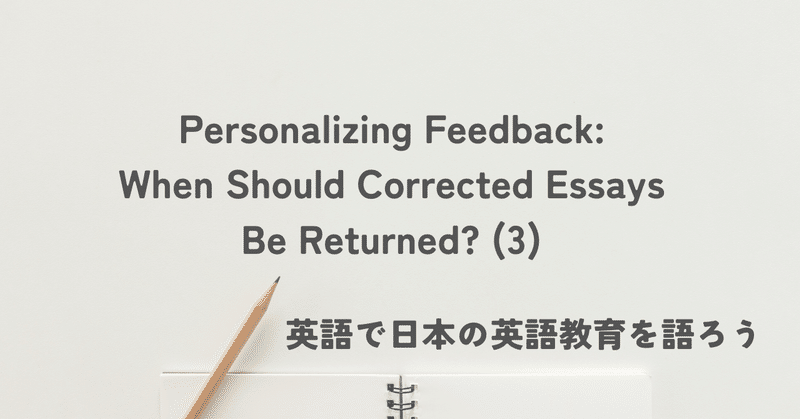
Personalizing Feedback: When Should Corrected Essays Be Returned? (3)
Deciding the best time to return graded essays during class has been a topic of my previous post. As I mentioned before, the ideal process for feedback and returning work is as follows:
Provide common error feedback related to grammar and vocabulary to the entire class.
Return individual essays.
Offer advice on content and structure, prompting reflection.
In my previous post, I discussed Point 1. This time, I will focus on Point 3, advice on content and structure.
Feedback on Content and Structure
Just like grammatical feedback, feedback on content and structure should also be provided by showing models of English sentences that include common errors and asking students to think about what is wrong and how it can be corrected. Let me illustrate this with an example.
Imagine students wrote essays on the topic: "Do you think high school students should have their own smartphones?" (Let's ignore how outdated this topic might seem!)
Here's a sample essay to discuss what could be improved:
I think that high school students should have their own smartphones. Smartphones are very useful. For example, you can contact your friends, classmates, family, and so on.
The key here is relevance to the topic. The topic is about "high school students owning smartphones," so mentioning that "they are useful for communication" isn’t specific to high school students. During discussions, we might suggest a revised version like this:
I think that high school students should have their own smartphones. Smartphones are particularly useful for high school students because we often need to contact others. For example, we can ask our classmates about homework, call our parents when we're going home late, and so on.
We would focus on the bolded part, ensuring students understand why the revision is more relevant to high school students. This way, they see how relevance directly impacts the persuasiveness of an essay and are encouraged to revise with this in mind.
I believe that such feedback on content and structure is more effective when students have their graded essays at hand. This leads to what I might call "personalizing feedback."
Personalizing Feedback
While discussing and advising on content and structure, if students have their own essays in front of them, they can not only consider the provided sample essay but also think, "Does my essay have similar issues?" or "Can I apply these revisions to my essay?" This is what I mean by personalizing feedback.
In one of my previous posts, I mentioned two classes. In Class A, where I returned essays before giving feedback on content, I saw many revised essays effectively incorporating my feedback. Even essays that didn’t receive specific content-related comments in the draft were improved, showing that students had internalized the feedback on their own.
Focusing and Innovating in Feedback and Essay Return
This series of posts has aimed to explore the process of returning graded essays. How can we deliver feedback most effectively? How can we best prompt students to think about certain issues in their essays? The nature of the feedback and the issues we want students to consider can dictate the most effective teaching approach.
(This is an English version of my previous post, フィードバックの「自分ごと化」のために(添削したエッセイをどのタイミングで返却すべきか③).)
この記事が気に入ったらサポートをしてみませんか?
